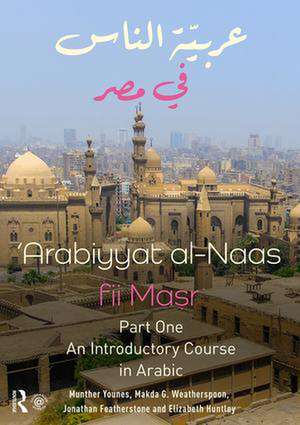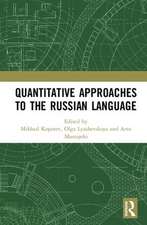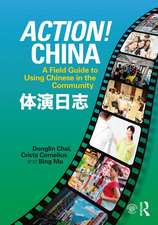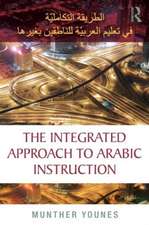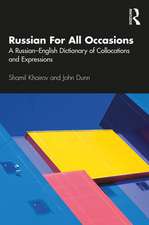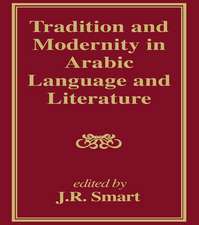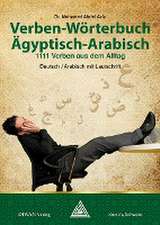Arabiyyat al-Naas fii MaSr (Part One): An Introductory Course in Arabic
Autor Munther Younes, Makda Weatherspoon, Elizabeth Huntley, Jonathan Featherstoneen Limba Engleză Paperback – 24 dec 2019
It combines a progressive and rigorous grounding in Modern Standard Arabic (MSA), the register employed for reading, writing and formal speaking, with an innovative integration of the dominant Egyptian variety. Introducing the two simultaneously and seamlessly building on their shared features, ‘Arabiyyat al-Naas fii MaSr (Part One) uses each in its proper context: Egyptian dialect for conversations and MSA for reading and writing activities. In this way, the course efficiently prepares students for the practical realities of learning and living Arabic today.
Features include:
- Expanded grammar explanations and activation drills, including discussions about colloquial and formal similarities and differences
- A series of authentic video-clips recorded in Egypt to help learners revise the vocabulary and structures then learn unit by unit
- Extensive classroom activities and homework exercises that provide constant review to reinforce learning
- Arabic-English and English-Arabic glossaries, reference charts, and a grammar index
- Songs with simple lyrics tied to the themes of the course to help advance vocabulary acquisition and understanding of basic grammatical structures
- A companion website (www.routledge.com/cw/weatherspoon) that features fully integrated interactive, self-correcting exercises, audio and video materials, and additional online course management and grading options for teachers
- A user-friendly and vibrant text design with full colour, richly illustrated throughout with over two hundred illustrations and photos
- A teachers manual with an Arabic introduction for the teacher, which lays out the structure of the student course book, its methodology and directions and suggestions for its use.
Preț: 601.53 lei
Preț vechi: 661.03 lei
-9% Nou
Puncte Express: 902
Preț estimativ în valută:
115.11€ • 119.50$ • 95.99£
115.11€ • 119.50$ • 95.99£
Carte disponibilă
Livrare economică 03-17 martie
Livrare express 14-20 februarie pentru 65.42 lei
Preluare comenzi: 021 569.72.76
Specificații
ISBN-13: 9781138065154
ISBN-10: 1138065153
Pagini: 508
Ilustrații: 228 Tables, black and white
Dimensiuni: 210 x 297 x 27 mm
Greutate: 1.45 kg
Ediția:1
Editura: Taylor & Francis
Colecția Routledge
Locul publicării:Oxford, United Kingdom
ISBN-10: 1138065153
Pagini: 508
Ilustrații: 228 Tables, black and white
Dimensiuni: 210 x 297 x 27 mm
Greutate: 1.45 kg
Ediția:1
Editura: Taylor & Francis
Colecția Routledge
Locul publicării:Oxford, United Kingdom
Cuprins
Table of Contents
Acknowledgements
Introduction
UNIT 1: ARABIC ALPHABET AND NUMBERS
Lesson 1: I am a Student - انا طالب
The Letters: أ، ن، ا، ط، ل، ب، س، ة
The Numbers: 1-10
Vocabulary: أنا، طالب/طالبة، بطاطس، لبنان
Grammar: The Arabic sentence (انا طالب)
Lesson 2: I am from.... – انا من ....
The Letters: م، د، ي، و، ر، ف، ت
The Numbers: 11-20
Vocabularyدولة، مدينة، ليبيا، سوريا، السودان، اليمن، طرابلس، بيروت، فلوريدا، بريطانيا، فرنسا في، من،
Lesson 3: The city of ….is big or small? - مدينة .... كبيرة ولا صغيرة؟
The Letters: ج، ك، ص، غ، ش، ق
The Numbers: 10-100
Vocabulary: كبير/كبيرة، صغير/صغيرة، شمال، جنوب، شرق، غرب، مصر، دمشق
Grammar: Introduction of the Construct
Lesson 4: The Weather - الجوّ
The Letters and Diacritics: خ، ح، ث، ع، ء، فتحة، كسرة، ضمّة
The Numbers: 21-30
Vocabulary: الصيف، الخريف، الشتاء، الربيع، جو، بارد، حار، ثلج، مطر، شمس، السعودية، عُمان، عمان، العراق، بغداد
Grammar: The Definite Article الـ; Sun and Moon Letters – الحروف الشمسيّة والقمريّة
Lesson 5: Is the Weather cold in April? – الجوّ بارد في شهر أبريل؟
The Letters: هـ، إ، لا، اً، ى (الف مقصورة)
The Numbers: 100 and above
Vocabulary: شهر (شهور)، سنة (سنوات)، النهار ده، يوم (أيام)، الاحد، الاثنين، الثلاثاء، الأربعاء، الخميس، الجمعة، السبت
Grammar: Negation – (مش/ما فيش)
Lesson 6: I live in an apartment – أنا ساكن في شقّة
The Letters and Diacritics: ض، شدّة، سكون
Vocabulary: ساكِن، بيت، شقّة، أوضة، بيت طلبة، بعيد عن، قريب من، هو، هي
Grammar: Noun-Adjective Agreement
Lesson 7: I have one brother – عندي أخ واحد
The Letter: ئ
Vocabulary: عائلة، أب، أمّ، أخ، أُخت، عنده، عندها، عندك، كم، اسم (اسمه، الخ..)، عُمر
Grammar: Possession (my, your, his, hers); Possession with عند; كم + the Singular
Lesson 8: My sister is an engineer and has three children! – 62
أُختي مُهندسة وعندها ثلاث أولاد!
The Letters: ذ، ظ
Vocabulary: أستاذ/أستاذة، طبيب/طبيبة، دكتور/دكتورة، مهندس/مهندسة، مهندس/كمبيوتر، سكرتير/سكرتيرة، مكتب، مدرسة، جامعة، بنك، مُستشفى
Grammar: The Singular, Dual and Plural
Lesson 9: I have an Arabic Lesson at 10 O’clock!
عندي درس عربي الساعة عشرة!
The Letter: ز
Vocabulary رياضيات/اقتصاد/ ساعة، دقيقة، نص، ربع، ثلث، نص وخمسة، نص إلا خمسة، درس، كيمياء، فيزياء،
عربي، أدَب إنجليزي، أحياء، تاريخ، هندسة
Grammar: Number-Noun (Dis-)agreement
Lesson 10: The Arab Countries and their Capitals – الدول العربيّة وعواصمها
Review of Letters and Diacritics; Note on writing non-Arabic names
Vocabulary review; عاصمة (عواصم)
Grammar: More on the iDaafa Construct – الإضافة
الوحدة الثانية: أهلاً وسهلاً في القاهِرة!
SECOND UNIT: WELCOME TO CAIRO!
الدرس الأوّل-أهمّ كلمات الوحدة وتمارين عليها
الدرس الثاني
النصّ الأوّل: مُشاهدة (Video): عنواني في مصر ولّا في أمريكا؟!
النصّ الثاني: استماع (Audio): في مطار القاهرة
قَواعِد (Grammar)
Plural Pronouns; Plural Possession
الدرس الثالث
النصّ الأوّل: استماع (Audio): مايا جونسون (Maya Johnson)
النصّ الثاني: قراءة (reading): عائلة مايا (Maya’s Family)
قَواعِد (Grammar)
Noun-Adjective Agreement; Non-human Plurals
الدرس الرابع
النصّ الأوّل: قراءة (ٍReading): بطاقة تأشيرة دخول
النصّ الثاني: مواعيد وصول الطائرات
قَواعِد
The Nisba Adjective (النسبة); Arabic Equational Sentences (no verb to be in the present tense)
الدرس الخامس-كلمات الوحدة؛ مراجعة وتمارين إضافيّة - Unit Wrap-up and Additional Exercises
Sociolinguistic Corner (طائرة/طيّارة)
الوحدة الثالثة: التاكسي
الدرس الأوّل-أهمّ كلمات الوحدة وتمارين عليها
الدرس الثاني-مُشاهدة: على فين في القاهرة؟
قَواعِد
Expressing "to want" in Egyptian Arabic (مصري)
الدرس الثالث
النصّ الأوّل: استماع: رحلة مايا من أمريكا لمصر
النصّ الثاني: استماع: عيلة "أمجد"
قَواعِد
The past tense verb, stems
الدرس الرابع
النصّ الأوّل: قراءة-مواعيد قطارات خطّ القاهرة
النصّ الثاني: المُدن المصريّة
الدرس الخامس-كلمات الوحدة؛ مراجعة وتمارين إضافيّة
قراءة: خدمات "اوبر" في القاهرة (Uber taxi services in Cairo)
قواعد
Review of negation in مصري
Sociolinguistic corner قَطَر/قِطار
كلمات متقاطعة (Crossword puzzle)
الوحدة الرابعة: الفُندُق
الدرس الأوّل-أهمّ كلمات الوحدة وتمارين عليها
الدرس الثاني-مُشاهدة-أوضة بحمّام طبعاً!
قَواعِد
Possession: عندي vs. معي
الدرس الثالث
النصّ الأوّل: استماع: زعلانة ليه؟
النصّ الثاني: قراءة- فنادق القاهرة
قَواعِد
Arabic Root Types
الدرس الرابع-قراءة:مذكّرات مايا (Maya’s Diary)
قَواعِد
Hollow Verb Conjugation in the Past Tense; Definiteness possession and noun-adjective agreement
الدرس الخامس
كلمات الوحدة؛ مراجعة وتمارين إضافيّة
قراءة: بيت الشباب ”ميراميس“ (ميراميس هوستل)
قواعد
Grammar Review: Noun-adjective phrases/iDaafa/Equational Sentences
Sociolinguistic Corner: معي/معاي
الوحدة الخامسة: جواز السفر
الدرس الأوّل-أهمّ كلمات الوحدة وتمارين عليها
أغنية (Song): البيت الأبيض بابه أحمر
الدرس الثاني-مشاهدة-جواز سفري ضاع!
قَواعِد
More on the Active Participle
الدرس الثالث
استماع: اسمك بالكامل لو سمحتِ!
قَواعِد
Sound and Broken Plural Patterns
الدرس الرابع
النصّ الأوّل: قراءة: مطار القاهرة الدولي - صندوق المفقودات
النصّ الثاني: مذكّرات مايا – Maya’s Diary
قَواعِد
Direct Objects and Object Pronoun Suffixes
الدرس الخامس
كلمات الوحدة؛ مراجعة وتمارين إضافيّة
Sociolinguistic Corner: The Past Tense (الفعل الماضي) in فصحى and مصري
كلمات متقاطعة
الوحدة السادسة: المطعم
الدرس الأوّل-أهمّ كلمات الوحدة وتمارين عليها
الدرس الثاني-مشاهدة: فيه مطعم قريب؟
قَواعِد
The Comparative
الدرس الثالث-استماع: كل حاجة موجودة في مطعم أم حسن!
قَواعِد
The Present Tense (المُضارع)
الدرس الرابع
النصّ الأوّل: قراءة: مطار القاهرة الدولي - صندوق المفقودات
النصّ الثاني: مذكّرات مايا
قَواعِد
The Particle أن in فُصحى; The Particle أنّ; Adjectives with إضافة phrases
الدرس الخامس
كلمات الوحدة؛ مراجعة وتمارين إضافيّة
قراءة: مطعم قدّروة
Sociolinguistic Corner: The Present Tense (الفعل المضارع) in فصحى and مصري; Expressing "To Want" in both فصحى and مصري
الوحدة السابعة: السكن
الدرس الأوّل-أهمّ كلمات الوحدة وتمارين عليها
الدرس الثاني-مشاهدة: حَتسكني فين؟
قَواعِد
More on the Present Tense in مصري: The prefix ب; Verb Negation
الدرس الثالث
النصّ الأوّل-استماع: عندك أوضة للإيجار؟
النصّ الثاني-استماع: كام الإيجار في الشهر؟
قَواعِد
Root Types: Doubled Roots in مصري
الدرس الرابع
النصّ الأوّل: قراءة: للإجار
النصّ الثاني: مذكّرات مايا
Note about آ (alif madda)
قَواعِد
Negation of the present tense (المُضارع) in فُصحى; Expressing the Future in فصحى; More uses of أنْ, The Case System in فُصحى
الدرس الخامس
كلمات الوحدة؛ مراجعة وتمارين إضافيّة
أغنية: حبّيتك وباحبّك وحاحبّك على طول (محمّد عبد المطّلب)
قواعد
More on Plural Patterns
الوحدة الثامنة: المواصلات
الدرس الأوّل-أهمّ كلمات الوحدة وتمارين عليها
الدرس الثاني-مشاهدة: أروح وسط البلد إزّاي؟
قَواعِد
The particle إنّ
الدرس الثالث
استماع: التاكسي المُميّز
قَواعِد
The Superlative; More examples ofإعراب (the فصحى case system); Relative clauses modifying indefinite nouns
الدرس الرابع-قراءة: مذكّرات مايا
قَواعِد
Verb-subject (dis)agreement in فُصحى
الدرس الخامس
كلمات الوحدة؛ مراجعة وتمارين إضافيّة
قراءة: تاكسي النيل
Grammar Review: The Comparative and Superlative; Roots and families
Sociolinguistic Corner: أنّ/إنّ ; ليس/مِش
الوحدة التاسعة: الجوّ
الدرس الأوّل-أهمّ كلمات الوحدة وتمارين عليها
الدرس الثاني-مشاهدة: إزّاي الجو في أمريكا؟
قَواعِد
Relative clauses modifying definite nouns ; The Resumptive (or Returning) Pronoun (الضمير العائد)
الدرس الثالث-استماع: هنا في مصر الشتاء يعني المطر!
قَواعِد: قبل ما
الدرس الرابع-قراءة: مذكّرات مايا
قَواعِد
Root Types: Assimilated Roots; Negation of the past tense in فصحى; Dual agreement
الدرس الخامس
كلمات الوحدة؛ مراجعة وتمارين إضافيّة
قَواعِد
Noun and Adjective Stems
كلمات مُتقاطعة
Sociolinguistic Corner: جه- ييجي in مصري and جاء-يجيء in فصحى
الوحدة العاشرة: العائلة والمهن
الدرس الأوّل-أهمّ كلمات الوحدة وتمارين عليها
الدرس الثاني- مشاهدة: كم أخ وأخت عندك يا مايا؟
قواعد
More on the present tense (المُضارع) in مصري
الدرس الثالث-استماع: أنا خايف ريم ما بتذاكرش كويّس!
قواعد
Root Types: Final-weak Roots
الدرس الرابع: مذكّرات مايا
قواعِد
أن لا; Case endings
الدرس الخامس
كلمات الوحدة؛ مراجعة وتمارين إضافيّة
الوحدة رقم ١١: الدراسة
الدرس الأوّل-أهمّ كلمات الوحدة وتمارين عليها
الدرس الثاني-مشاهدة: حتدرسي ايه بالضبط؟
قواعد
Expressing Possession in the Past Tense with كان; بتاع، بتاعة، بتوع; Note on Stress in مصري
الدرس الثالث-قراءة: جامعات عربية قديمة
قواعد
Passive Voice in فصحى; مِن أقدَم
الدرس الرابع-مذكّرات مايا
قواعد
أمّا... ف; Moods of the Present Tense Verb
الدرس الخامس
كلمات الوحدة؛ مراجعة وتمارين إضافيّة
قراءة: الجامعة الأمريكيّة بالقاهرة
قواعِد: قبل ما
Sociolinguistic corner: Relative Pronouns
الوحدة رقم ١٢: الأعياد والمناسبات
الدرس الأوّل: أهمّ كلمات الوحدة وتمارين عليها
الدرس الثاني-مشاهدة: بتعرفي حاجة عن عيد الأضحى!
قواعد
Root Types: Summary
الدرس الثالث
النصّ الأوّل-استماع: انتو المصريّين بتحتفلوا بأعياد كثيرة!
النصّ الثاني: قراءة: الاحتفال بأعياد الميلاد
قواعد
Review of إنّ/أنّ and أنْ
الدرس الرابع-مذكّرات مايا
قواعد
قَد; The Forms of the Arabic Verb; Forms I and VIII
الدرس الخامس
كلمات الوحدة؛ مراجعة وتمارين إضافيّة
Sociolinguistic Corner: بدأت تنتشر; Relative Pronouns; Arabic equivalents of English that
الوحدة رقم ١٣: التسوّق
الدرس الأوّل: أهمّ كلمات الوحدة وتمارين عليها
الدرس الثاني-مشاهدة: في سوق التوفيقية في وسط البلد.
قواعد: اثنين كيلو، أربعة دولار
الدرس الثالث-استماع: قميص قُطن ولّا جلّابيّة؟
قواعِد
The Imperative in مصري
الدرس الرابع-مذكّرات مايا
Past Tense Negation with لم; Form II and IV
الدرس الخامس
كلمات الوحدة؛ مراجعة وتمارين إضافيّة
استماع: بكم رغيف العيش لو سمحت؟؛ كلمات متقاطعة
Sociolinguistic Corner: على راسي
الوحدة رقم ١٤: الأكل والصحّة
الدرس الأوّل: أهمّ كلمات الوحدة وتمارين عليها
الدرس الثاني-مشاهدة: الفتة لذيذة قوي!
قواعد: شاربة
الدرس الثالث-استماع: كلّنا أكلنا الفتة وما تعبناش!
قواعد: عيّانة، تعبانة
الدرس الرابع-مذكّرات مايا
قواعد: تفعّل واستفعل (Forms V and X)
الدرس الخامس
كلمات الوحدة؛ مراجعة وتمارين إضافيّة
قواعِد
The use of كان to express past and future actions and states
قِراءة: كلمات أجنبيّة دخلت العربيّة
الوحدة رقم ١٥: الرياضة والهوايات
الدرس الأوّل-أهمّ كلمات الوحدة وتمارين عليها
الدرس الثاني-مشاهدة: ايه رياضتك المفضّلة؟
الدرس الثالث
النصّ الأوّل-قراءة: التعرّف على شباب وشابّات.
النصّ الثاني-قراءة: زين الدين زيدان
قواعد
The Verbal Noun (المصدر)
الدرس الرابع-مذكّرات مايا
الدرس الخامس
كلمات الوحدة؛ مراجعة وتمارين إضافيّة
قواعد
The Conjunction ف; Looking up words in the dictionary
كلمات متقاطعة
الوحدة رقم ١٦: أسئلة غريبة
الدرس الأوّل-أهمّ كلمات الوحدة وتمارين عليها
الدرس الثاني-مشاهدة: انتِ مخطوبة ولّا لسّه؟
قواعد: بقى لك قدّ ايه؟
الدرس الثالث-استماع: بتدرسي عربي عشان بتحبي المحشي؟
قواعد: شَكله مصري، شكلها مصريّة
الدرس الرابع-مذكّرات مايا
قواعد
هل; More on verb negation in فُصحى
الدرس الخامس
كلمات الوحدة؛ مراجعة وتمارين إضافيّة
Sociolinguistic Corner: حبّ-يحبّ، أحَبّ-يُحِبّ
الوحدة رقم ١٧: زيارة مناطق أخرى الدرس الأوّل-أهمّ كلمات الوحدة وتمارين عليها
الدرس الثاني-مشاهدة: المعادي والزمالك زيّ أمريكا وأوروبا، ولّا لأ؟
قواعد: حتوحشيني؛ Form VIII of Assimilated Roots
الدرس الثالث- قراءة: الإسكندريّة
الدرس الرابع-مذكّرات مايا
قواعد: أعجبني؛ اسم الفاعل واسم المفعول (the active and passive participle)
الدرس الخامس
كلمات الوحدة؛ مراجعة وتمارين إضافيّة
قواعد
Negation in فصحى and مصري
الوحدة رقم ١٨: زيارة فلسطين
الدرس الأوّل-أهمّ كلمات الوحدة وتمارين عليها
الدرس الثاني-مشاهدة: أصلي من مدينة يافا.
الدرس الثالث-قراءة: القُدس
قواعد: افتعل (Form VIII)
الدرس الرابع-مذكّرات مايا
قواعد
Past Tense Negation with لَم and Hollow Root Verbs; Form VII (انفعل)
الدرس الخامس
كلمات الوحدة؛ مراجعة وتمارين إضافيّة
الوحدة رقم ١٩: انطباعات مايا
الدرس الأوّل-أهمّ كلمات الوحدة وتمارين عليها
الدرس الثاني-انطِباعات مايا-الجُزء الأوّل
قواعد: كُنت قَد +فعل؛ لم يستطيعوا
الدرس الثالث-انطِباعات مايا-الجُزء الثاني
قواعد: تفاعل (Form VI)
الدرس الرابع-انطِباعات مايا-الجُزء الثالث والأخير
قواعد
Verb Form Summary
الدرس الخامس
كلمات الوحدة؛ مراجعة وتمارين إضافيّة
Index of Grammatical Terms
Glossary
Acknowledgements
Introduction
UNIT 1: ARABIC ALPHABET AND NUMBERS
Lesson 1: I am a Student - انا طالب
The Letters: أ، ن، ا، ط، ل، ب، س، ة
The Numbers: 1-10
Vocabulary: أنا، طالب/طالبة، بطاطس، لبنان
Grammar: The Arabic sentence (انا طالب)
Lesson 2: I am from.... – انا من ....
The Letters: م، د، ي، و، ر، ف، ت
The Numbers: 11-20
Vocabularyدولة، مدينة، ليبيا، سوريا، السودان، اليمن، طرابلس، بيروت، فلوريدا، بريطانيا، فرنسا في، من،
Lesson 3: The city of ….is big or small? - مدينة .... كبيرة ولا صغيرة؟
The Letters: ج، ك، ص، غ، ش، ق
The Numbers: 10-100
Vocabulary: كبير/كبيرة، صغير/صغيرة، شمال، جنوب، شرق، غرب، مصر، دمشق
Grammar: Introduction of the Construct
Lesson 4: The Weather - الجوّ
The Letters and Diacritics: خ، ح، ث، ع، ء، فتحة، كسرة، ضمّة
The Numbers: 21-30
Vocabulary: الصيف، الخريف، الشتاء، الربيع، جو، بارد، حار، ثلج، مطر، شمس، السعودية، عُمان، عمان، العراق، بغداد
Grammar: The Definite Article الـ; Sun and Moon Letters – الحروف الشمسيّة والقمريّة
Lesson 5: Is the Weather cold in April? – الجوّ بارد في شهر أبريل؟
The Letters: هـ، إ، لا، اً، ى (الف مقصورة)
The Numbers: 100 and above
Vocabulary: شهر (شهور)، سنة (سنوات)، النهار ده، يوم (أيام)، الاحد، الاثنين، الثلاثاء، الأربعاء، الخميس، الجمعة، السبت
Grammar: Negation – (مش/ما فيش)
Lesson 6: I live in an apartment – أنا ساكن في شقّة
The Letters and Diacritics: ض، شدّة، سكون
Vocabulary: ساكِن، بيت، شقّة، أوضة، بيت طلبة، بعيد عن، قريب من، هو، هي
Grammar: Noun-Adjective Agreement
Lesson 7: I have one brother – عندي أخ واحد
The Letter: ئ
Vocabulary: عائلة، أب، أمّ، أخ، أُخت، عنده، عندها، عندك، كم، اسم (اسمه، الخ..)، عُمر
Grammar: Possession (my, your, his, hers); Possession with عند; كم + the Singular
Lesson 8: My sister is an engineer and has three children! – 62
أُختي مُهندسة وعندها ثلاث أولاد!
The Letters: ذ، ظ
Vocabulary: أستاذ/أستاذة، طبيب/طبيبة، دكتور/دكتورة، مهندس/مهندسة، مهندس/كمبيوتر، سكرتير/سكرتيرة، مكتب، مدرسة، جامعة، بنك، مُستشفى
Grammar: The Singular, Dual and Plural
Lesson 9: I have an Arabic Lesson at 10 O’clock!
عندي درس عربي الساعة عشرة!
The Letter: ز
Vocabulary رياضيات/اقتصاد/ ساعة، دقيقة، نص، ربع، ثلث، نص وخمسة، نص إلا خمسة، درس، كيمياء، فيزياء،
عربي، أدَب إنجليزي، أحياء، تاريخ، هندسة
Grammar: Number-Noun (Dis-)agreement
Lesson 10: The Arab Countries and their Capitals – الدول العربيّة وعواصمها
Review of Letters and Diacritics; Note on writing non-Arabic names
Vocabulary review; عاصمة (عواصم)
Grammar: More on the iDaafa Construct – الإضافة
الوحدة الثانية: أهلاً وسهلاً في القاهِرة!
SECOND UNIT: WELCOME TO CAIRO!
الدرس الأوّل-أهمّ كلمات الوحدة وتمارين عليها
الدرس الثاني
النصّ الأوّل: مُشاهدة (Video): عنواني في مصر ولّا في أمريكا؟!
النصّ الثاني: استماع (Audio): في مطار القاهرة
قَواعِد (Grammar)
Plural Pronouns; Plural Possession
الدرس الثالث
النصّ الأوّل: استماع (Audio): مايا جونسون (Maya Johnson)
النصّ الثاني: قراءة (reading): عائلة مايا (Maya’s Family)
قَواعِد (Grammar)
Noun-Adjective Agreement; Non-human Plurals
الدرس الرابع
النصّ الأوّل: قراءة (ٍReading): بطاقة تأشيرة دخول
النصّ الثاني: مواعيد وصول الطائرات
قَواعِد
The Nisba Adjective (النسبة); Arabic Equational Sentences (no verb to be in the present tense)
الدرس الخامس-كلمات الوحدة؛ مراجعة وتمارين إضافيّة - Unit Wrap-up and Additional Exercises
Sociolinguistic Corner (طائرة/طيّارة)
الوحدة الثالثة: التاكسي
الدرس الأوّل-أهمّ كلمات الوحدة وتمارين عليها
الدرس الثاني-مُشاهدة: على فين في القاهرة؟
قَواعِد
Expressing "to want" in Egyptian Arabic (مصري)
الدرس الثالث
النصّ الأوّل: استماع: رحلة مايا من أمريكا لمصر
النصّ الثاني: استماع: عيلة "أمجد"
قَواعِد
The past tense verb, stems
الدرس الرابع
النصّ الأوّل: قراءة-مواعيد قطارات خطّ القاهرة
النصّ الثاني: المُدن المصريّة
الدرس الخامس-كلمات الوحدة؛ مراجعة وتمارين إضافيّة
قراءة: خدمات "اوبر" في القاهرة (Uber taxi services in Cairo)
قواعد
Review of negation in مصري
Sociolinguistic corner قَطَر/قِطار
كلمات متقاطعة (Crossword puzzle)
الوحدة الرابعة: الفُندُق
الدرس الأوّل-أهمّ كلمات الوحدة وتمارين عليها
الدرس الثاني-مُشاهدة-أوضة بحمّام طبعاً!
قَواعِد
Possession: عندي vs. معي
الدرس الثالث
النصّ الأوّل: استماع: زعلانة ليه؟
النصّ الثاني: قراءة- فنادق القاهرة
قَواعِد
Arabic Root Types
الدرس الرابع-قراءة:مذكّرات مايا (Maya’s Diary)
قَواعِد
Hollow Verb Conjugation in the Past Tense; Definiteness possession and noun-adjective agreement
الدرس الخامس
كلمات الوحدة؛ مراجعة وتمارين إضافيّة
قراءة: بيت الشباب ”ميراميس“ (ميراميس هوستل)
قواعد
Grammar Review: Noun-adjective phrases/iDaafa/Equational Sentences
Sociolinguistic Corner: معي/معاي
الوحدة الخامسة: جواز السفر
الدرس الأوّل-أهمّ كلمات الوحدة وتمارين عليها
أغنية (Song): البيت الأبيض بابه أحمر
الدرس الثاني-مشاهدة-جواز سفري ضاع!
قَواعِد
More on the Active Participle
الدرس الثالث
استماع: اسمك بالكامل لو سمحتِ!
قَواعِد
Sound and Broken Plural Patterns
الدرس الرابع
النصّ الأوّل: قراءة: مطار القاهرة الدولي - صندوق المفقودات
النصّ الثاني: مذكّرات مايا – Maya’s Diary
قَواعِد
Direct Objects and Object Pronoun Suffixes
الدرس الخامس
كلمات الوحدة؛ مراجعة وتمارين إضافيّة
Sociolinguistic Corner: The Past Tense (الفعل الماضي) in فصحى and مصري
كلمات متقاطعة
الوحدة السادسة: المطعم
الدرس الأوّل-أهمّ كلمات الوحدة وتمارين عليها
الدرس الثاني-مشاهدة: فيه مطعم قريب؟
قَواعِد
The Comparative
الدرس الثالث-استماع: كل حاجة موجودة في مطعم أم حسن!
قَواعِد
The Present Tense (المُضارع)
الدرس الرابع
النصّ الأوّل: قراءة: مطار القاهرة الدولي - صندوق المفقودات
النصّ الثاني: مذكّرات مايا
قَواعِد
The Particle أن in فُصحى; The Particle أنّ; Adjectives with إضافة phrases
الدرس الخامس
كلمات الوحدة؛ مراجعة وتمارين إضافيّة
قراءة: مطعم قدّروة
Sociolinguistic Corner: The Present Tense (الفعل المضارع) in فصحى and مصري; Expressing "To Want" in both فصحى and مصري
الوحدة السابعة: السكن
الدرس الأوّل-أهمّ كلمات الوحدة وتمارين عليها
الدرس الثاني-مشاهدة: حَتسكني فين؟
قَواعِد
More on the Present Tense in مصري: The prefix ب; Verb Negation
الدرس الثالث
النصّ الأوّل-استماع: عندك أوضة للإيجار؟
النصّ الثاني-استماع: كام الإيجار في الشهر؟
قَواعِد
Root Types: Doubled Roots in مصري
الدرس الرابع
النصّ الأوّل: قراءة: للإجار
النصّ الثاني: مذكّرات مايا
Note about آ (alif madda)
قَواعِد
Negation of the present tense (المُضارع) in فُصحى; Expressing the Future in فصحى; More uses of أنْ, The Case System in فُصحى
الدرس الخامس
كلمات الوحدة؛ مراجعة وتمارين إضافيّة
أغنية: حبّيتك وباحبّك وحاحبّك على طول (محمّد عبد المطّلب)
قواعد
More on Plural Patterns
الوحدة الثامنة: المواصلات
الدرس الأوّل-أهمّ كلمات الوحدة وتمارين عليها
الدرس الثاني-مشاهدة: أروح وسط البلد إزّاي؟
قَواعِد
The particle إنّ
الدرس الثالث
استماع: التاكسي المُميّز
قَواعِد
The Superlative; More examples ofإعراب (the فصحى case system); Relative clauses modifying indefinite nouns
الدرس الرابع-قراءة: مذكّرات مايا
قَواعِد
Verb-subject (dis)agreement in فُصحى
الدرس الخامس
كلمات الوحدة؛ مراجعة وتمارين إضافيّة
قراءة: تاكسي النيل
Grammar Review: The Comparative and Superlative; Roots and families
Sociolinguistic Corner: أنّ/إنّ ; ليس/مِش
الوحدة التاسعة: الجوّ
الدرس الأوّل-أهمّ كلمات الوحدة وتمارين عليها
الدرس الثاني-مشاهدة: إزّاي الجو في أمريكا؟
قَواعِد
Relative clauses modifying definite nouns ; The Resumptive (or Returning) Pronoun (الضمير العائد)
الدرس الثالث-استماع: هنا في مصر الشتاء يعني المطر!
قَواعِد: قبل ما
الدرس الرابع-قراءة: مذكّرات مايا
قَواعِد
Root Types: Assimilated Roots; Negation of the past tense in فصحى; Dual agreement
الدرس الخامس
كلمات الوحدة؛ مراجعة وتمارين إضافيّة
قَواعِد
Noun and Adjective Stems
كلمات مُتقاطعة
Sociolinguistic Corner: جه- ييجي in مصري and جاء-يجيء in فصحى
الوحدة العاشرة: العائلة والمهن
الدرس الأوّل-أهمّ كلمات الوحدة وتمارين عليها
الدرس الثاني- مشاهدة: كم أخ وأخت عندك يا مايا؟
قواعد
More on the present tense (المُضارع) in مصري
الدرس الثالث-استماع: أنا خايف ريم ما بتذاكرش كويّس!
قواعد
Root Types: Final-weak Roots
الدرس الرابع: مذكّرات مايا
قواعِد
أن لا; Case endings
الدرس الخامس
كلمات الوحدة؛ مراجعة وتمارين إضافيّة
الوحدة رقم ١١: الدراسة
الدرس الأوّل-أهمّ كلمات الوحدة وتمارين عليها
الدرس الثاني-مشاهدة: حتدرسي ايه بالضبط؟
قواعد
Expressing Possession in the Past Tense with كان; بتاع، بتاعة، بتوع; Note on Stress in مصري
الدرس الثالث-قراءة: جامعات عربية قديمة
قواعد
Passive Voice in فصحى; مِن أقدَم
الدرس الرابع-مذكّرات مايا
قواعد
أمّا... ف; Moods of the Present Tense Verb
الدرس الخامس
كلمات الوحدة؛ مراجعة وتمارين إضافيّة
قراءة: الجامعة الأمريكيّة بالقاهرة
قواعِد: قبل ما
Sociolinguistic corner: Relative Pronouns
الوحدة رقم ١٢: الأعياد والمناسبات
الدرس الأوّل: أهمّ كلمات الوحدة وتمارين عليها
الدرس الثاني-مشاهدة: بتعرفي حاجة عن عيد الأضحى!
قواعد
Root Types: Summary
الدرس الثالث
النصّ الأوّل-استماع: انتو المصريّين بتحتفلوا بأعياد كثيرة!
النصّ الثاني: قراءة: الاحتفال بأعياد الميلاد
قواعد
Review of إنّ/أنّ and أنْ
الدرس الرابع-مذكّرات مايا
قواعد
قَد; The Forms of the Arabic Verb; Forms I and VIII
الدرس الخامس
كلمات الوحدة؛ مراجعة وتمارين إضافيّة
Sociolinguistic Corner: بدأت تنتشر; Relative Pronouns; Arabic equivalents of English that
الوحدة رقم ١٣: التسوّق
الدرس الأوّل: أهمّ كلمات الوحدة وتمارين عليها
الدرس الثاني-مشاهدة: في سوق التوفيقية في وسط البلد.
قواعد: اثنين كيلو، أربعة دولار
الدرس الثالث-استماع: قميص قُطن ولّا جلّابيّة؟
قواعِد
The Imperative in مصري
الدرس الرابع-مذكّرات مايا
Past Tense Negation with لم; Form II and IV
الدرس الخامس
كلمات الوحدة؛ مراجعة وتمارين إضافيّة
استماع: بكم رغيف العيش لو سمحت؟؛ كلمات متقاطعة
Sociolinguistic Corner: على راسي
الوحدة رقم ١٤: الأكل والصحّة
الدرس الأوّل: أهمّ كلمات الوحدة وتمارين عليها
الدرس الثاني-مشاهدة: الفتة لذيذة قوي!
قواعد: شاربة
الدرس الثالث-استماع: كلّنا أكلنا الفتة وما تعبناش!
قواعد: عيّانة، تعبانة
الدرس الرابع-مذكّرات مايا
قواعد: تفعّل واستفعل (Forms V and X)
الدرس الخامس
كلمات الوحدة؛ مراجعة وتمارين إضافيّة
قواعِد
The use of كان to express past and future actions and states
قِراءة: كلمات أجنبيّة دخلت العربيّة
الوحدة رقم ١٥: الرياضة والهوايات
الدرس الأوّل-أهمّ كلمات الوحدة وتمارين عليها
الدرس الثاني-مشاهدة: ايه رياضتك المفضّلة؟
الدرس الثالث
النصّ الأوّل-قراءة: التعرّف على شباب وشابّات.
النصّ الثاني-قراءة: زين الدين زيدان
قواعد
The Verbal Noun (المصدر)
الدرس الرابع-مذكّرات مايا
الدرس الخامس
كلمات الوحدة؛ مراجعة وتمارين إضافيّة
قواعد
The Conjunction ف; Looking up words in the dictionary
كلمات متقاطعة
الوحدة رقم ١٦: أسئلة غريبة
الدرس الأوّل-أهمّ كلمات الوحدة وتمارين عليها
الدرس الثاني-مشاهدة: انتِ مخطوبة ولّا لسّه؟
قواعد: بقى لك قدّ ايه؟
الدرس الثالث-استماع: بتدرسي عربي عشان بتحبي المحشي؟
قواعد: شَكله مصري، شكلها مصريّة
الدرس الرابع-مذكّرات مايا
قواعد
هل; More on verb negation in فُصحى
الدرس الخامس
كلمات الوحدة؛ مراجعة وتمارين إضافيّة
Sociolinguistic Corner: حبّ-يحبّ، أحَبّ-يُحِبّ
الوحدة رقم ١٧: زيارة مناطق أخرى الدرس الأوّل-أهمّ كلمات الوحدة وتمارين عليها
الدرس الثاني-مشاهدة: المعادي والزمالك زيّ أمريكا وأوروبا، ولّا لأ؟
قواعد: حتوحشيني؛ Form VIII of Assimilated Roots
الدرس الثالث- قراءة: الإسكندريّة
الدرس الرابع-مذكّرات مايا
قواعد: أعجبني؛ اسم الفاعل واسم المفعول (the active and passive participle)
الدرس الخامس
كلمات الوحدة؛ مراجعة وتمارين إضافيّة
قواعد
Negation in فصحى and مصري
الوحدة رقم ١٨: زيارة فلسطين
الدرس الأوّل-أهمّ كلمات الوحدة وتمارين عليها
الدرس الثاني-مشاهدة: أصلي من مدينة يافا.
الدرس الثالث-قراءة: القُدس
قواعد: افتعل (Form VIII)
الدرس الرابع-مذكّرات مايا
قواعد
Past Tense Negation with لَم and Hollow Root Verbs; Form VII (انفعل)
الدرس الخامس
كلمات الوحدة؛ مراجعة وتمارين إضافيّة
الوحدة رقم ١٩: انطباعات مايا
الدرس الأوّل-أهمّ كلمات الوحدة وتمارين عليها
الدرس الثاني-انطِباعات مايا-الجُزء الأوّل
قواعد: كُنت قَد +فعل؛ لم يستطيعوا
الدرس الثالث-انطِباعات مايا-الجُزء الثاني
قواعد: تفاعل (Form VI)
الدرس الرابع-انطِباعات مايا-الجُزء الثالث والأخير
قواعد
Verb Form Summary
الدرس الخامس
كلمات الوحدة؛ مراجعة وتمارين إضافيّة
Index of Grammatical Terms
Glossary
Notă biografică
Munther Younes is Reis Senior Lecturer of Arabic Language and Linguistics and Director of the Arabic Program at Cornell University, USA. He is the co-author of the ‘Arabiyyat al-Naas textbook series and the author of the following books: The Routledge Introduction to Qur’anic Arabic, Kalila wa Dimna for Students of Arabic, The Integrated Approach to Arabic Instruction and Charging Steeds or Maidens Doing Good Deeds: In search of the Original Qur’an, all published by Routledge.
Makda G. Weatherspoon is a Senior Lecturer of Arabic at Cornell University, USA where she is the Coordinator of the Elementary Arabic Program. She has also taught at Middlebury Language Program and worked as a Curriculum Developer of online Arabic materials at the University of Cambridge, Language Centre, UK. Prior to that, she worked as an English instructor with immigrants who were preparing to take their American citizenship tests. Makda is the co-author of ‘Arabiyyat al-Naas (Part One).
Jonathan Featherstone is Senior Teaching Fellow of Arabic at the University of Edinburgh where he leads on an intensive Master’s degree in Arabic. Prior to this he taught Arabic at the Defence School of Languages in the UK, then at the Foreign and Commonwealth Office. Jonathan is also the author of BBC Talk Arabic.
Elizabeth (Lizz) Huntley is a current doctoral student in Second Language Studies at Michigan State University. She holds master’s degrees in Teaching Arabic as Foreign Language and in Middle Eastern and North African Studies from the University of Michigan. She has taught Arabic at the college-level at Cornell University and the University of Michigan, and at the high school level with the Concordia Language Villages, the Middlebury-Monterey Language Academy, and of the STARTALK Arabic Summer Academy of the Boston Public Schools.
Makda G. Weatherspoon is a Senior Lecturer of Arabic at Cornell University, USA where she is the Coordinator of the Elementary Arabic Program. She has also taught at Middlebury Language Program and worked as a Curriculum Developer of online Arabic materials at the University of Cambridge, Language Centre, UK. Prior to that, she worked as an English instructor with immigrants who were preparing to take their American citizenship tests. Makda is the co-author of ‘Arabiyyat al-Naas (Part One).
Jonathan Featherstone is Senior Teaching Fellow of Arabic at the University of Edinburgh where he leads on an intensive Master’s degree in Arabic. Prior to this he taught Arabic at the Defence School of Languages in the UK, then at the Foreign and Commonwealth Office. Jonathan is also the author of BBC Talk Arabic.
Elizabeth (Lizz) Huntley is a current doctoral student in Second Language Studies at Michigan State University. She holds master’s degrees in Teaching Arabic as Foreign Language and in Middle Eastern and North African Studies from the University of Michigan. She has taught Arabic at the college-level at Cornell University and the University of Michigan, and at the high school level with the Concordia Language Villages, the Middlebury-Monterey Language Academy, and of the STARTALK Arabic Summer Academy of the Boston Public Schools.
Recenzii
"Arabiyyat al-Naas fii MaSr is an added value to the field of teaching Arabic as a foreign language. It provides language learners with a functional language in its cultural context. Compared to other textbooks, the listening, reading, grammar and the drills, in this textbook, are well designed and will bring students to the intermediate low level as it intends. This book stands beyond many Arabic textbooks which are used internationally." Abdellah Chekayri, Assosciate Professor in the School of Humanities and Social Sciences, Al Akhawayn University, Morocco
"It is very important to me to be able to integrate both fusha and colloquial into the classroom. At the same time, I often feel that a large part of my role in teaching first year Arabic lies in helping to humanize Arabic speakers for my non-Arab, non-Muslim students, and this book does an excellent job of presenting a sympathetic approach to the Arab world. In addition, teaching in colloquial – because of the natural warmth and spontaneity of the language – may just help to make learning Arabic a bit less intimidating for our first year students. Because so many of our language teachers are most comfortable with the Egyptian dialect, I think that an Egyptian version of Arabiyyat al-Naas will be a fabulous addition to our teaching toolkit." Nancy A. Coffin, Senior Lecturer and Director of the Arabic Program at Princeton University, United States of America
"It is very important to me to be able to integrate both fusha and colloquial into the classroom. At the same time, I often feel that a large part of my role in teaching first year Arabic lies in helping to humanize Arabic speakers for my non-Arab, non-Muslim students, and this book does an excellent job of presenting a sympathetic approach to the Arab world. In addition, teaching in colloquial – because of the natural warmth and spontaneity of the language – may just help to make learning Arabic a bit less intimidating for our first year students. Because so many of our language teachers are most comfortable with the Egyptian dialect, I think that an Egyptian version of Arabiyyat al-Naas will be a fabulous addition to our teaching toolkit." Nancy A. Coffin, Senior Lecturer and Director of the Arabic Program at Princeton University, United States of America
Descriere
‘Arabiyyat al-Naas fii MaSr (Part One) offers a ground-breaking introduction to Arabic as it is written and spoken by native speakers.
